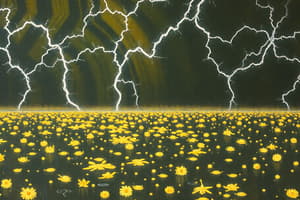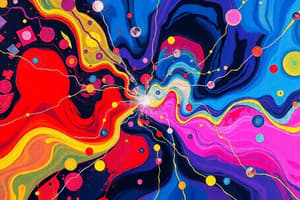Podcast
Questions and Answers
What type of charge does electrostatics primarily study?
What type of charge does electrostatics primarily study?
- Moving charges
- Accelerating charges
- Charges at rest (correct)
- Decelerating charges
What does Coulomb's Law quantify?
What does Coulomb's Law quantify?
- The force between two point charges (correct)
- The resistance in a circuit
- The speed of light
- The energy of a photon
What is electric potential defined as?
What is electric potential defined as?
- The energy stored in a capacitor
- The work done to bring a unit positive charge from infinity to a point (correct)
- The rate of charge flow
- The force on a test charge
What does capacitance measure?
What does capacitance measure?
What quantity is defined as the rate of flow of electric charge?
What quantity is defined as the rate of flow of electric charge?
Ohm's Law describes the relationship between which three quantities?
Ohm's Law describes the relationship between which three quantities?
What creates magnetic fields?
What creates magnetic fields?
What phenomenon involves inducing an EMF in a circuit due to a changing magnetic field?
What phenomenon involves inducing an EMF in a circuit due to a changing magnetic field?
What does Lenz's Law state about the direction of induced current?
What does Lenz's Law state about the direction of induced current?
What type of wave are electromagnetic waves?
What type of wave are electromagnetic waves?
Which phenomenon does ray optics primarily deal with?
Which phenomenon does ray optics primarily deal with?
What phenomenon is described as the bending of light as it passes from one medium to another?
What phenomenon is described as the bending of light as it passes from one medium to another?
What effect describes the emission of electrons from a metal surface when light shines on it?
What effect describes the emission of electrons from a metal surface when light shines on it?
What are semiconductors?
What are semiconductors?
What is modulation in the context of communication systems?
What is modulation in the context of communication systems?
Flashcards
Electrostatics
Electrostatics
Electric charges at rest and the forces between them.
Coulomb's Law
Coulomb's Law
Force between two point charges; proportional to charge magnitudes, inversely proportional to distance squared.
Electric Field
Electric Field
Region around a charge where another charge experiences force.
Electric Potential
Electric Potential
Signup and view all the flashcards
Gauss's Law
Gauss's Law
Signup and view all the flashcards
Capacitance
Capacitance
Signup and view all the flashcards
Electric Current
Electric Current
Signup and view all the flashcards
Ohm's Law
Ohm's Law
Signup and view all the flashcards
Resistance
Resistance
Signup and view all the flashcards
Magnetic Field
Magnetic Field
Signup and view all the flashcards
Faraday's Law of Induction
Faraday's Law of Induction
Signup and view all the flashcards
Lenz's Law
Lenz's Law
Signup and view all the flashcards
Alternating Current (AC)
Alternating Current (AC)
Signup and view all the flashcards
Electromagnetic Waves
Electromagnetic Waves
Signup and view all the flashcards
Refraction of Light
Refraction of Light
Signup and view all the flashcards
Study Notes
- Physics for class 12 encompasses several key areas, including electrostatics, current electricity, magnetic effects of current and magnetism, electromagnetic induction and alternating currents, electromagnetic waves, optics, dual nature of radiation and matter, atoms, nuclei, semiconductor electronics, and communication systems
Electrostatics
- Deals with the study of electric charges at rest
- Electric charge is a fundamental property of matter and comes in two types: positive and negative
- Coulomb's Law quantifies the force between two point charges
- The force is directly proportional to the product of the magnitudes of the charges and inversely proportional to the square of the distance between them
- Electric field is the region around a charge in which another charge experiences a force
- Electric potential is the work done to bring a unit positive charge from infinity to a point in an electric field
- Gauss's Law relates the electric flux through a closed surface to the enclosed charge
- Applications of Gauss's Law include finding the electric field due to various charge distributions, such as uniformly charged spheres, infinite line charges, and charged planes
- Capacitance is the ability of a conductor to store electric charge
- A capacitor is a device used to store electrical energy, typically consisting of two conductors separated by an insulator
- Series and parallel combinations of capacitors affect the total capacitance of the circuit
Current Electricity
- Involves the study of electric charges in motion
- Electric current is the rate of flow of electric charge through a conductor
- Ohm's Law relates voltage, current, and resistance in a circuit: V = IR
- Resistance is the opposition to the flow of current in a conductor
- Resistivity is a material property that determines its resistance
- Series and parallel combinations of resistors affect the total resistance of the circuit
- Kirchhoff's Laws, including the junction rule and loop rule, are used to analyze complex circuits
- Electric power is the rate at which electrical energy is converted into other forms of energy
Magnetic Effects of Current and Magnetism
- Moving charges create magnetic fields
- Biot-Savart Law describes the magnetic field created by a current-carrying wire
- Ampere's Law relates the integral of the magnetic field around a closed loop to the current passing through the loop
- The magnetic force on a moving charge is given by F = q(v x B)
- Magnetic force on a current-carrying conductor in a magnetic field is F = I(L x B)
- A moving coil galvanometer is used to detect and measure small electric currents
- Magnetism and matter involves the study of magnetic materials
- Earth's magnetic field can be described using magnetic declination and inclination
- Magnetic properties of materials include diamagnetism, paramagnetism, and ferromagnetism
Electromagnetic Induction and Alternating Currents
- Electromagnetic induction is the phenomenon of inducing an electromotive force (EMF) in a circuit due to a changing magnetic field
- Faraday's Law of Induction states that the induced EMF is equal to the rate of change of magnetic flux
- Lenz's Law states that the direction of the induced current opposes the change in magnetic flux
- Self-induction is the induction of an EMF in a coil due to its own changing magnetic field
- Mutual induction is the induction of an EMF in one coil due to the changing magnetic field of another coil
- An alternating current (AC) is an electric current that periodically reverses direction
- AC circuits contain resistors, inductors, and capacitors
- The average and RMS values of AC voltage and current are important for power calculations
- Reactance is the opposition to the flow of AC current due to inductance and capacitance
- Impedance is the total opposition to the flow of AC current in a circuit
- Resonance occurs in AC circuits when the inductive reactance equals the capacitive reactance
- Power in AC circuits depends on the phase difference between voltage and current
- Transformers are used to step up or step down AC voltages
Electromagnetic Waves
- Electromagnetic waves are transverse waves consisting of oscillating electric and magnetic fields
- Electromagnetic waves are produced by accelerating charges
- Electromagnetic spectrum consists of radio waves, microwaves, infrared, visible light, ultraviolet, X-rays, and gamma rays
- Properties of electromagnetic waves include wavelength, frequency, speed, and energy
- EM waves can propagate through a vacuum
- Electromagnetic waves carry energy and momentum
- Applications of electromagnetic waves include communication, medicine, and industry
Optics
- Ray optics deals with the rectilinear propagation of light and phenomena such as reflection, refraction, and dispersion
- Reflection of light follows the laws of reflection: the angle of incidence equals the angle of reflection
- Refraction of light is the bending of light as it passes from one medium to another
- Snell's Law relates the angles of incidence and refraction to the refractive indices of the media
- Total internal reflection occurs when light travels from a denser to a rarer medium at an angle greater than the critical angle
- Optical instruments include lenses, mirrors, prisms, and optical fibers
- Wave optics deals with the wave nature of light and phenomena such as interference, diffraction, and polarization
- Huygens' Principle states that every point on a wavefront can be considered as a source of secondary spherical wavelets
- Interference of light occurs when two or more waves superimpose
- Young's double-slit experiment demonstrates the interference of light
- Diffraction of light is the bending of light around obstacles
- Polarization of light is the restriction of the vibrations of the electric field vector to a single plane
Dual Nature of Radiation and Matter
- Light exhibits both wave-like and particle-like properties
- Photoelectric effect is the emission of electrons from a metal surface when light shines on it
- Einstein's photoelectric equation relates the energy of the incident photon to the kinetic energy of the emitted electron
- Matter waves are associated with moving particles
- De Broglie wavelength is the wavelength associated with a moving particle, given by λ = h/p
Atoms
- Thomson's model
- Rutherford's nuclear model of the atom
- Bohr model of the hydrogen atom explains the discrete energy levels of atoms
- Energy levels and spectra of hydrogen atom
Nuclei
- Composition and size of the nucleus
- Nuclear force
- Mass defect and binding energy
- Nuclear reactions
- Radioactivity
Semiconductor Electronics
- Semiconductors are materials with conductivity between that of conductors and insulators
- Intrinsic semiconductors are pure semiconductors
- Extrinsic semiconductors are doped semiconductors
- P-type semiconductors are doped with acceptor impurities
- N-type semiconductors are doped with donor impurities
- P-N junction is formed when a p-type and n-type semiconductor are joined together
- Semiconductor diode is a p-n junction diode that allows current to flow in one direction only
- Transistors are semiconductor devices used for amplification and switching
- Digital electronics involves the use of logic gates to perform logical operations
Communication Systems
- Elements of a communication system include the transmitter, channel, and receiver
- Modulation is the process of superimposing a message signal onto a carrier wave
- Types of modulation include amplitude modulation (AM), frequency modulation (FM), and phase modulation (PM)
- Bandwidth is the range of frequencies occupied by a signal
- Propagation of electromagnetic waves through the atmosphere depends on their frequency
Studying That Suits You
Use AI to generate personalized quizzes and flashcards to suit your learning preferences.




